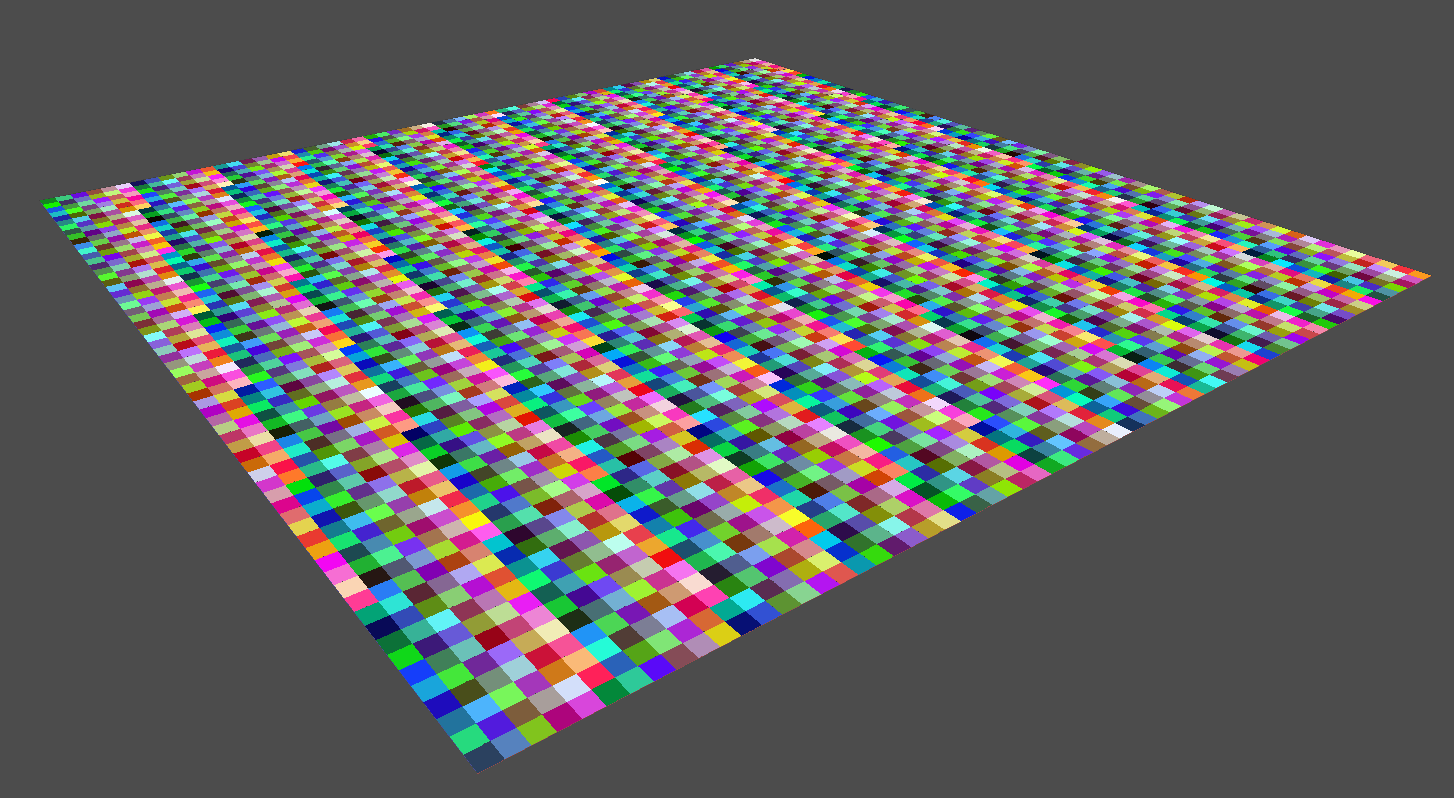There's not much code here, but I think it can be pretty cleanly divided into two parts:
- Generate three bytes for a color from an integer
- Have a way of getting multiple integers which are guaranteed to be unique
Simple as your algorithm is, you're already running into limitations by coupling these two pieces of functionality together (which, by the way, makes this an excellent object lesson in the importance of the Single Responsibility Principle!)
Namely, in your question, all the colors are red, and in your answer, you're still getting colors following a completely deterministic numeric pattern. Depending on your offset, this pattern will be more or less obvious (it's not just low vs. high- I'm pretty sure there's an offset which would give you the first image with red turned to blue, for example).
So, let's see what we can do about this unwanted coupling.
Separating Responsibilities
As I said before, you have two pieces of functionality. The first is given by these lines:
byte red = ( byte )( _colorIndex & 0x000000FF );
byte green = ( byte )( ( _colorIndex & 0x0000FF00 ) >> 08 );
byte blue = ( byte )( ( _colorIndex & 0x00FF0000 ) >> 16 );
return Color.FromArgb( red , green , blue );
This makes a nice unit of functionality itself, with a single, simple purpose: Get a color from an integer index. So put the above in a method (say, GetColorFromIndex, with index as a parameter replacing _colorIndex).
The other ingredient is generating unique integers. This is what you really want to separate out into its own class, implementing an interface. That way, you can generate numbers however you want to get different patterns: increment by one, increment by an offset, use the numbers 1 to N shuffled randomly, whatever you can think of! By using polymorphism, instead of being limited to one way of generating numbers with some potential for parametrization (like offsetIncrement), you will be able to use whatever algorithms you want.
Fortunately, an interface already exists for exactly what you want: IEnumerable<int>. You can often think of an IEnumerable<T> as a collection to iterate over, but in some situations I find it more conceptually useful to think of it as a box that I can just keep asking for a new T (though it may eventually reach the end of its Ts). In this case, that's exactly what you want- a box you can just keep pulling integers out of.
So let's pull this together:
public class ColorGenerator
{
private IEnumerator<int> _indexGenerator;
public ColorGenerator(IEnumerable<int> indexGenerator)
{
_indexGenerator = indexGenerator.GetEnumerator();
}
public Color Next()
{
_indexGenerator.MoveNext();
return GetColorFromIndex(_indexGenerator.Current);
}
private Color GetColorFromIndex(int index)
{
byte red = ( byte )( index & 0x000000FF );
byte green = ( byte )( ( index & 0x0000FF00 ) >> 08 );
byte blue = ( byte )( ( index & 0x00FF0000 ) >> 16 );
return Color.FromArgb( red , green , blue );
}
}
Note that now I've removed Unique from the name- it's now the responsibility of the passed in IEnumerable<int> to decide if it's unique or not.
I'll leave implementing IEnumerable<int> for your 'color offset' version as an exercise, it should be straightforward.
IEnumerable
Okay, the above is a bit ugly- lots of fiddling with enumerators, and unhandled error cases (what happens if you reach the end of a finite collection of integers?). But this is because we're missing another trick: ColorGenerator itself is a box you can pull Colors out of, so it should itself be an IEnumerable<Color>. The structure of just repeatedly asking for a "Next" value very closely matches how IEnumerator<T>is laid out. So that aforementioned ugliness is a code smell specific to C# hinting at this to us.
So, making that adjustment, we end up with:
public class ColorGenerator : IEnumerable<Color>
{
private IEnumerable<int> _indexGenerator;
public ColorGenerator(IEnumerable<int> indexGenerator)
{
_indexGenerator = indexGenerator;
}
public IEnumerator<Color> GetEnumerator()
{
foreach(var index in _indexGenerator)
{
yield return GetColorFromIndex(index);
}
}
private Color GetColorFromIndex(int index)
{
byte red = ( byte )( index & 0x000000FF );
byte green = ( byte )( ( index & 0x0000FF00 ) >> 08 );
byte blue = ( byte )( ( index & 0x00FF0000 ) >> 16 );
return Color.FromArgb( red , green , blue );
}
}
Now, as a bonus from our refactoring we get all the power and expressiveness of LINQ extensions for our color generator. If we want 10 colors, instead of:
var colors = new List<Color>();
for(int i=0; i<10; i++)
{
colors.Add(colorGenerator.Next());
}
We can do:
var colors = colorGenerator.Take(10);


